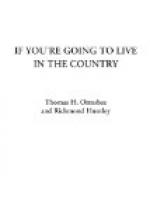“The plague of a smoking fireplace is proverbial,” began Rumford in his treatise on the subject, written during his years in the service of the Elector of Bavaria. Stripped of the involved terminology characteristic of the natural philosopher of that day, his specifications for a smokeless, heat-radiating fireplace are very simple and depend on three fundamentals. First, the size of flue must be in proportion to the fireplace opening. Second, the angles of back and jambs must be such that they will reflect heat into the room. Third, throat and smoke chamber of proper size and shape are essential because the former improves the draft while the latter prevents smoke from being blown out into the room by a down draft within the chimney flue.
From this it is clear that the New England-reared count of the Holy Roman Empire was really describing the type and design of fireplace in general use at home in his boyhood and explaining the scientific reasons for its superiority over European rectangular ones, built throatless and without a smoke chamber. As stated before, technical men today generally go back to Rumford’s work and the American tradition behind it, but in one particular they make a wise departure. Instead of a single common flue, they advocate separate ones for each fireplace.
These modern specifications, based on several centuries of good practice, are as follows: The fireplace should be at least 18 inches deep and have a hearth 20 inches wide. The size of opening must of course be in proportion to the dimensions of the room, but one with lintel less that 26 inches above the hearth is not practical because of difficulty in tending the fire. A good maximum height is 42 inches. The width should be in accord and exceed it so that the opening is a well-proportioned rectangle with its greater dimension horizontal.
In our country home, built about 1765, there are three fireplaces, each of different size and proportions. The largest, where the cooking was done, is 50 inches wide by 37 inches high and 18 inches deep. The one in the old parlor has a width of 38-1/2 inches, a height of 28-1/2 inches, and a depth of 13-1/2 inches. The smallest has an opening just off the square which is 27 inches wide by 25-1/2 inches high with a depth of only 11 inches. All three are non-smokers under all conditions of wind and weather. With proper size of wood they are easy to tend and good sources of warmth except in real winter weather. Each is individualistic in hearth dimensions, the largest of course being that of the old kitchen with a hearthstone over seven feet long by two feet wide.
Whether heat radiates into the room, or goes up the chimney along with the smoke, depends on the angles of fireplace sides and back. The former should be set at an angle of about 60 degrees so that they flare outward from the back wall. There are two schools of thought regarding the back. One would have the forward pitch begin one third of the distance from floor to lintel; the other favors the slope starting at the bottom and continuing upward in an unbroken plane. In the former, the pitch should be about 23 degrees from the vertical; with the latter, 18 degrees will suffice.




